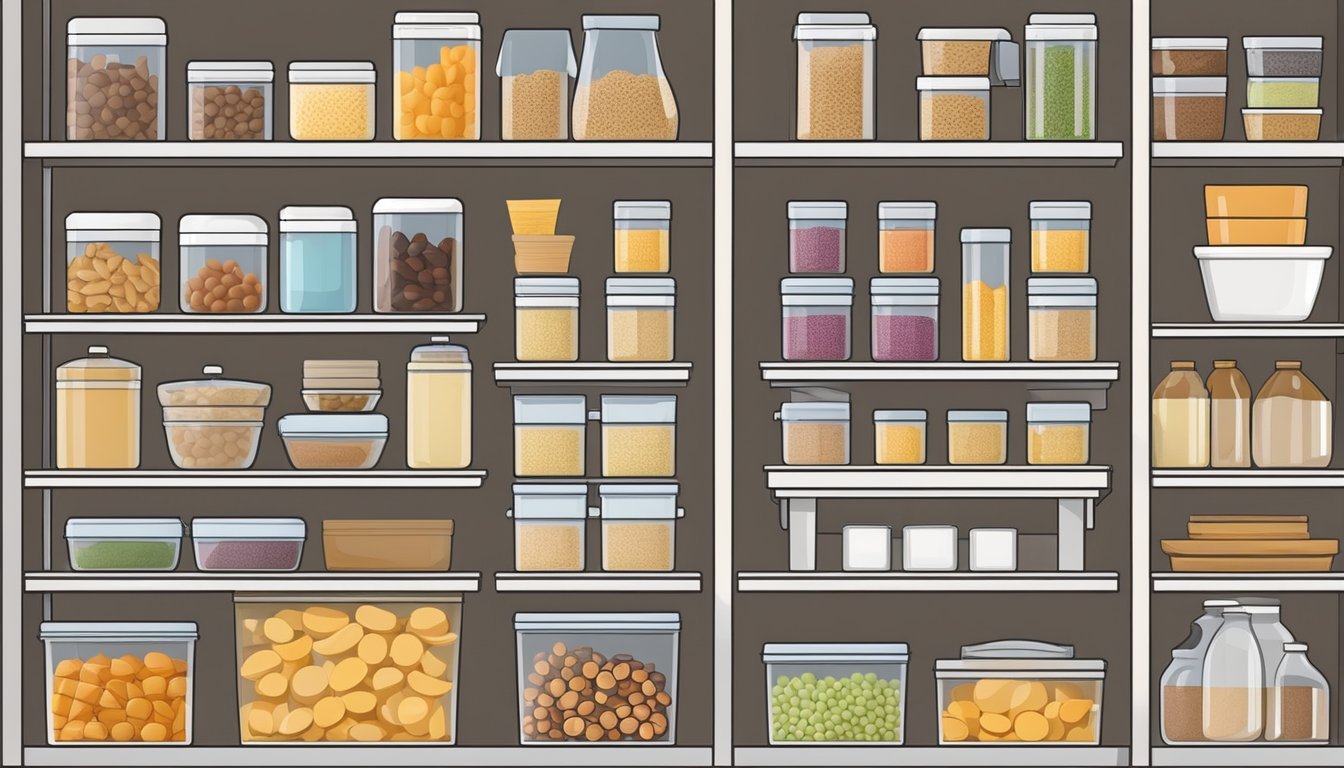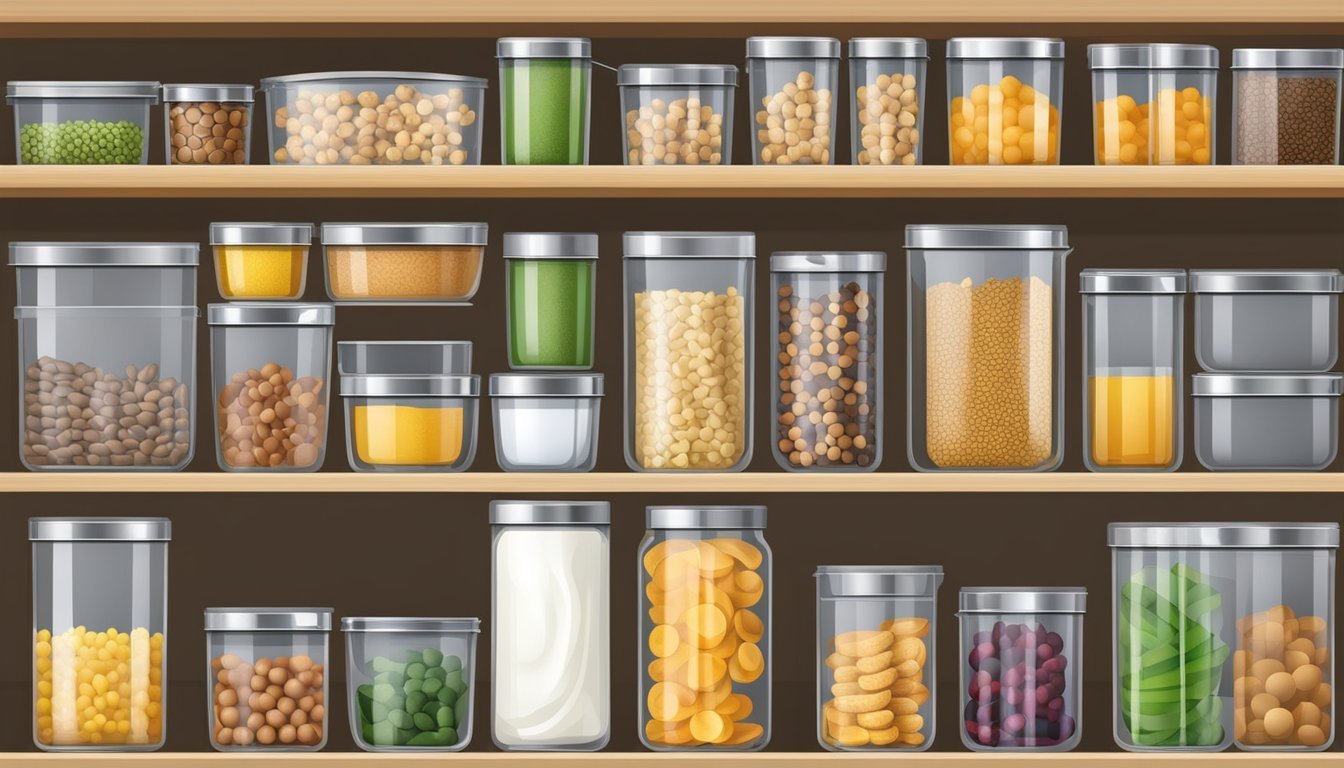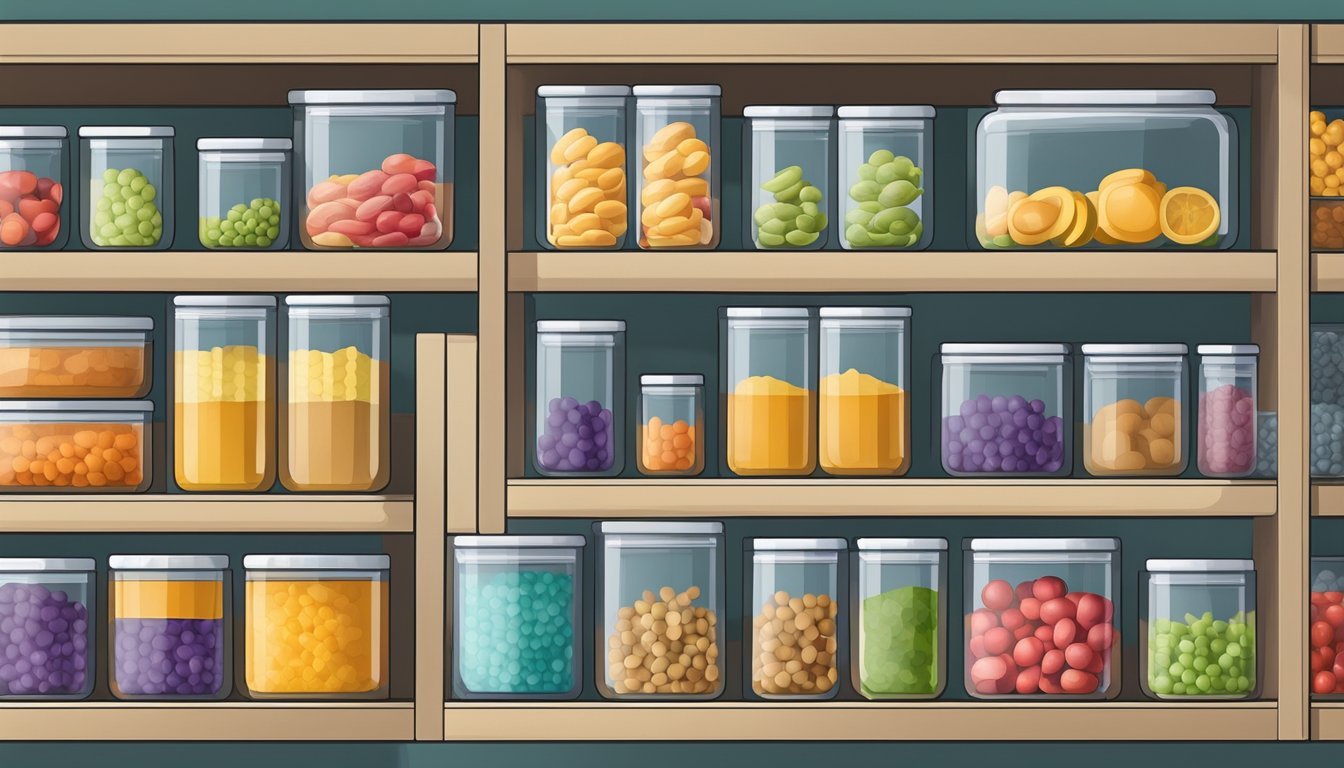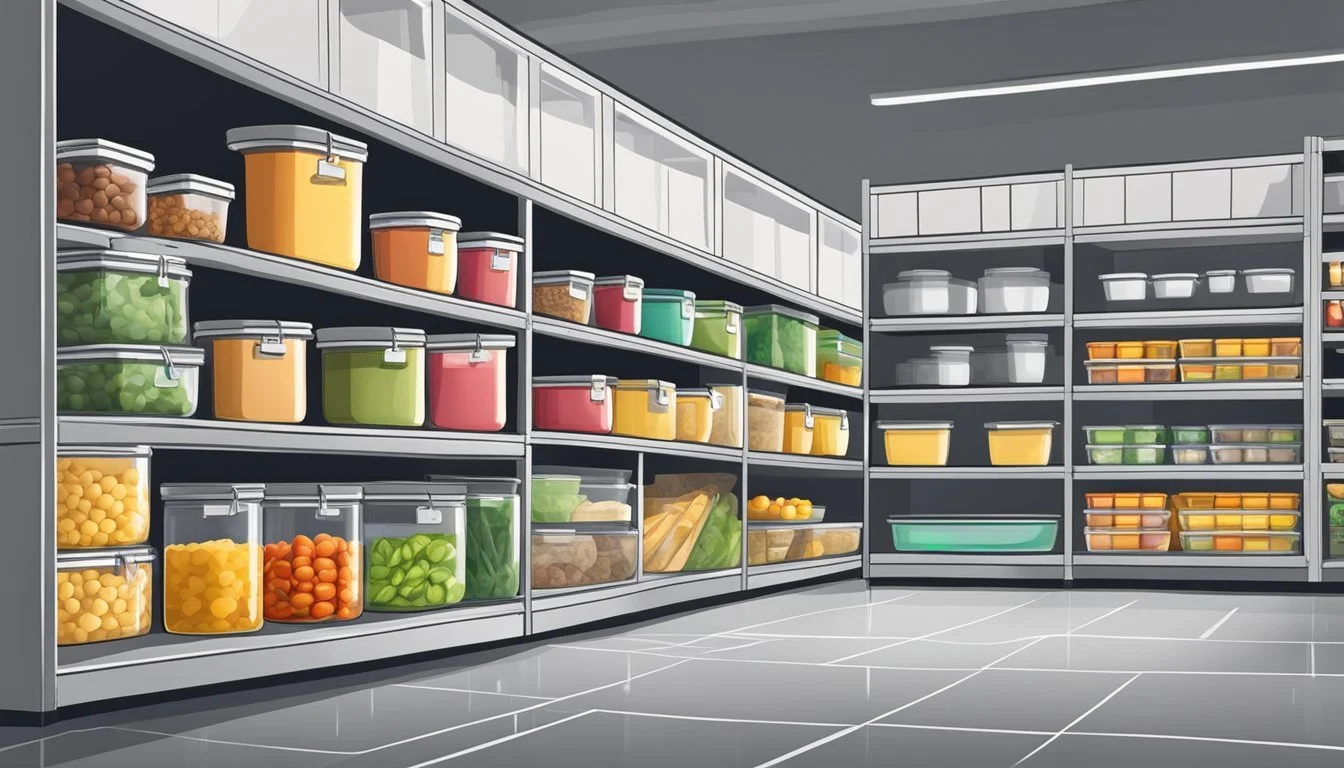The Best Food Storage Containers for Your Pantry
Optimal Solutions for Organization
Choosing the right food storage containers is essential for maintaining a well-organized pantry, prolonging the shelf life of food, and preventing waste. With a myriad of options on the market, it can be overwhelming to discern which containers best suit your needs. The material, size, and design are key factors that dictate the functionality of food storage containers, influencing how they stack, seal, and preserve pantry items.
Large airtight containers are often the preferred choice for storing bulk quantities of dry goods such as flour, sugar, and pasta. The Vtopmart Large Food Storage Containers, for instance, are noteworthy for their generous 5.2-liter capacity and stackability, optimizing space for those with more vertical storage options. Meanwhile, the efficiency of a container's seal is crucial in extending the freshness of its contents, and this is where sets like the OXO Good Grips POP Containers excel, featuring an easily accessible seal that locks out air and moisture.
Moreover, longevity and durability are important for consumers who prefer not to replace their containers frequently. Options like the Lock & Lock Easy Essentials Food Storage Container Set offer a variety of shapes and sizes at an affordable price point, while also being known for a reliable locking system. Material choices range from glass, which is oven-safe and resists staining and odors, to lightweight plastics that are often BPA-free and dishwasher safe. The Heritage Collection by Tupperware emphasizes this versatility with its comprehensive set of 36 containers, accommodating various food storage needs with a nod to vintage style.
Understanding Food Storage Container Materials
Choosing the right material for food storage containers is crucial to ensure durability, food safety, and sustainability. Each material offers unique benefits and drawbacks, suited to a variety of kitchen needs.
Plastic Containers: Pros and Cons
Plastic containers are lightweight, making them easy to handle and ideal for everyday use. Many are BPA-free, ensuring no harmful chemicals leach into the food. However, they can retain odors and stains over time and may not be as durable as other materials. Pros include:
Lightweight and impact-resistant
Often microwave and dishwasher safe
Inexpensive
Cons involve:
Potential for warping or melting with heat
Can hold onto stains and odors
Environmental concerns with disposability
Glass Containers: Clarity and Durability
Glass containers offer a high level of clarity, allowing users to easily view their contents. They are also incredibly durable and can last for years without showing signs of wear. Glass is generally safe for use in the freezer, microwave, and dishwasher. It's an eco-friendly choice that won't retain odors or stains. However, it can be heavy and is prone to breaking upon impact.
Alternative Materials: Silicone, Stainless Steel, and Ceramic
Silicone containers are flexible, often collapsible, and can withstand extreme temperatures, making them versatile for both cooking and storage. Stainless steel options are sturdy, durable, and typically BPA-free, but they're not microwave-safe and can be pricier. Ceramic containers, while often aesthetically pleasing, are heavy and like glass, may break easily. They usually offer excellent heat retention properties.
Silicone: Heat-resistant, flexible, non-reactive
Stainless Steel: Long-lasting, non-reactive, not microwave-safe
Ceramic: Visually appealing, maintains temperature, fragile
Choosing the Right Size and Shape
Selecting the perfect food storage containers involves understanding one's pantry needs regarding capacity and how easily containers can stack. It's also important to consider the practicality of container openings for everyday use.
Capacity and Stackability
Capacity is crucial, as it determines how much of any given item can be stored. For leftovers, a range of 16-32 ounces is commonly sufficient whereas dry goods like flour or sugar often require larger containers, approximately 4-5 liters, to maintain freshness and quantity over time.
When it comes to stackability, containers should be designed to easily nest within each other or stack securely on top, reducing wasted space. By choosing stackable containers, users maximize pantry organization, allowing for a clean and easily accessible space. Look for sets with uniform shapes to ensure they stack well.
Wide Mouth vs. Narrow Opening
The design of the container opening is a key factor for usability. A wide-mouth container facilitates:
Easy filling and dispensing of contents
More efficient cleaning and drying
Containers with narrow openings, meanwhile, may be better for pouring liquids or items that can spill easily, but they can be more difficult to fill with bulk goods and to clean. The best choice depends on one's individual needs—wide mouths for bulk items and convenient access, narrow openings for controlled dispensing.
Sealing Mechanisms for Freshness
Effective food storage containers support preserving food quality by incorporating advanced sealing technologies. Unique lid designs and sealing materials contribute to maintaining freshness and preventing leaks.
Airtight Lids and Silicone Seals
Food storage containers with airtight lids are equipped with silicone seals that conform to the rim to create a tight seal. This barrier keeps out air and moisture, critical factors in prolonging the freshness of stored food. Silicone, a flexible and durable material, ensures the rim of the container remains sealed even with repeated use.
Locking Lids and Leakproof Features
Containers with locking lids typically feature a mechanism that snaps or clamps down onto the container, compressing the seal further and securing the lid in place. Leakproof containers go a step further by incorporating special gaskets or additional sealing strategies that reinforce the barrier, ensuring liquids and odors are contained, and preventing spills even when the container is tipped over.
Lid Design and Functionality
The lid design plays a pivotal role in how well a container maintains its seal. Some lids are designed with a recess for the silicone seal, adding an extra level of protection against air and moisture ingress. Additionally, the functionality of the lid often includes easy-to-use tabs or handles, aiding in the effortless opening and closing of the container while preserving the integrity of the seal.
Organizing Your Pantry with Storage Containers
Properly organized pantry storage containers can create an efficient kitchen space, allowing for easy access to dry goods while keeping them fresh. Strategic use of sets, configurations, and labeling are key to a well-organized pantry.
Sets vs. Individual Containers
Purchasing storage container sets can provide a uniform look and are often designed to fit together neatly, saving space. However, one may choose individual containers to tailor storage solutions to specific needs, accommodating varied item sizes. When selecting sets, it's essential to consider the variety of products stored and whether the set's range of container sizes meets those needs.
Nesting and Modular Configurations
Containers that nest within each other benefit users by saving space when not in use. Modular systems, which stack securely, maximize vertical space in the pantry and can be reconfigured as needs change. Rubbermaid's mix-and-match line offers different shapes and sizes that can enhance any kitchen's organization strategy, promoting a neat, clutter-free environment.
Visibility and Labeling
Containers with a clear view allow users to quickly see the contents and track inventory at a glance, thereby reducing search time and food waste. OXO's stackable Pop Containers, for example, come in a range of sizes and have transparent sides. Adding labels to containers ensures that everyone can identify the contents and return items to their proper place, thus maintaining order. A neatly labeled system aids in the fuss-free retrieval and storage of pantry items.
Specialized Containers for Specific Needs
Choosing the right food storage containers can transform one's pantry, and ensure food stays fresh longer. Specific containers cater to various needs such as preserving dry foods, facilitating meal prep, convenient transport, and keeping produce fresh.
Containers for Dry Foods and Cereals
For dry food storage, airtight containers are essential. OXO Good Grips POP Containers have become a popular choice for their tight seals which preserve the freshness of dry goods such as flour, sugar, and cereals. The clear design allows for easy identification of contents, and the stackable nature makes efficient use of space.
Freezer-Safe Options for Meal Prep
Freezer-safe containers must withstand low temperatures without cracking while maintaining a seal against freezer burn. Pyrex Simply Store Meal Prep Storage Containers provide a durable glass option that can go from freezer to microwave, making them ideal for meal prep enthusiasts. Their tight-fitting lids prevent leaks and odors in the freezer.
Transport-Friendly Containers for On-The-Go
Containers designed for transport must prevent leaks and be sturdy enough to handle travel without opening accidentally. Lock & Lock Easy Essentials Food Storage lids click into place confidently and are known for being easy to seal and lock, which is crucial for carrying meals to work or school without spillage.
Produce Containers for Extended Freshness
To keep produce fresh, containers often have vent technology that adjusts airflow, preserving the life of fruits and vegetables. CHEFSTORY Airtight Food Storage Containers feature tight-fitting lids and sturdy design, which prevents moisture accumulation and extends the freshness of produce when stored in the fridge.
Practicalities for Everyday Use
Selecting the best food storage containers for your pantry goes beyond aesthetic appeal and sizes. One must consider how they will hold up during cleaning, use in appliances, and their ability to prevent stains and smells—affecting both longevity and food quality.
Cleaning and Maintenance
Dishwasher-safe features are crucial for easy maintenance. Brands like Rubbermaid and CHEFSTORY offer containers designed for hassle-free cleaning. However, it's important to note that specific parts, such as lids, may not tolerate high heat and thus should be washed by hand to avoid warping.
Microwave, Dishwasher, and Oven Safety
Containers that are microwave-safe save time by allowing for direct reheating. Dishwasher-safe attributes support sanitation without damaging the seal or material, and those that are oven-safe provide additional versatility. Both Rubbermaid and Lock & Lock provide ranges that broadly support these features. When using in any appliance, always verify the manufacturer's guidance.
Detecting and Preventing Stains and Smells
Using stain-resistant materials, such as hard plastic or glass, can deter discoloration and lingering odors. Tupperware sets are known for their stain-resistant designs, ensuring that foods with intense colors or acidic contents do not leave a permanent mark. Proper sealing is essential to prevent both stains and smells; thus, containers with tight-fitting, secure lids are preferred.
Safety and Health Considerations
When selecting food storage containers for your pantry, health and safety are paramount. It's important to consider the materials used and how they interact with food, especially under various conditions such as heat. The two critical areas to focus on are the implications of BPA in plastics and the risks associated with warping and chemical leaching.
BPA-Free Options and Health Implications
Bisphenol A, or BPA, is a chemical traditionally used in the manufacture of plastics. BPA-free containers are essential as BPA exposure has been linked to health issues, including hormonal disruptions and potential risks to the heart and brain. Consumers should opt for containers labeled as BPA-free to minimize these health risks. One popular material is Tritan plastic, which is known for being durable and BPA-free, ensuring no harmful chemicals leach into food.
Avoiding Warping and Chemical Leaching
Containers can become warped when exposed to high temperatures, often in microwaves or dishwashers. Warping not only compromises the seal and functionality of the container but also raises concerns about the leaching of chemicals into food. To avoid this:
Ensure containers are labeled as microwave-safe and dishwasher-safe.
Limit exposure to high temperatures to prevent warping.
Maintaining the integrity of food storage containers helps protect your health by reducing the risk of chemical contamination.
Durability and Longevity Assessment
When selecting food storage containers for long-term use, one must consider their durability and longevity. These factors are imperative to ensure that the containers not only protect food but also withstand repeated use. The assessment of these attributes involves structured testing by experts and the study of the container's lifespan over time.
Benchmark Testing by Experts
Expert analyses and standardized testing play a pivotal role in evaluating the durability of food storage containers. Glass containers are assessed for their resistance to chipping or shattering, while plastic variants undergo stress tests for flexibility and crack resistance. In controlled lab environments, silicone seals are examined for their ability to maintain elasticity. Consumer Reports has conducted tests on 25 popular food storage containers, scrutinizing materials like glass, stainless steel, and silicone for their durability to keep contents fresh.
Glass Food Storage Container: Tested for its resilience to temperature changes and impact.
Plastic Food Storage Container: Evaluated for warping or staining resistance, particularly after microwave or dishwasher use.
Long-Term Research on Container Lifespan
Research conducted over extended periods provides insight into the longevity of food storage containers. The focus is on how containers like glass and plastic fare over time with regular use, considering factors such as:
Seal integrity and the ability to prevent leaks
Latch robustness and its long-term functionality
Stain retention and odor absorption, which can indicate material degradation
Through accumulating consumer feedback and revisiting product performance periodically, one can establish a comprehensive lifespan profile. For example, the Pyrex Simply Store Meal Prep glass food storage container, although it leaked a few tablespoons of water in short-term testing, did not leak at all when shaken, suggesting a robust design for everyday use.
Accessories and Additional Features
When selecting the best food storage solutions for a pantry, accessories and additional features can significantly enhance the functionality and preservation quality of food storage. These include options for improved airtight sealing, innovative technology for extended freshness, and environmentally friendly alternatives.
Reusable Bags and Flexible Containers
Reusable bags offer an eco-friendly alternative to single-use plastic. They often come with airtight seals, ensuring that ingredients like grains and snacks remain fresh. Similarly, flexible containers can adapt to various storage needs and space constraints, enabling one to maximize pantry organization while being compact for storage.
Key attributes of Reusable Bags and Flexible Containers:
Airtight quality: Ensures prolonged freshness
Flexibility: They can be reshaped or rolled up, occupying minimal space when not in use
Vacuum Seals and Advanced Technology
Containers with vacuum seals utilize a mechanism to remove air from the container, extending the shelf life of perishable goods. Additionally, advancements in food storage technology often lead to features like smart tracking labels or freshness indicators. Such technology offers a proactive approach to managing food storage and maintaining quality.
Benefits of Vacuum Seals and Advanced Technology:
Feature Benefit Vacuum Seal Removes air to prevent oxidation and prolong food freshness. Smart Technology Allows tracking of contents and monitors freshness levels.
Each of these accessories and features serves to maintain the integrity of ingredients stored and to optimize the use and space of a pantry.
Cost and Budget Considerations
When choosing the best food storage containers for one's pantry, cost and budget considerations play a pivotal role. The market offers a range of options from high-end brands to affordable alternatives, and a cost-benefit analysis can guide consumers in making a well-informed investment.
High-End Brands vs. Affordable Alternatives
The market for food storage containers features a broad spectrum of brands. High-end options like Glasslock and Pyrex are known for their durability and often come with a heftier price tag. For example, Pyrex containers are lauded for their resistance to leaking and odors, although some tests show minor imperfections such as slight leakage and lingering smells. Stasher bags offer a reusable silicone option, albeit with an increased initial cost.
On the other end, brands like Rubbermaid and Snapware offer more budget-friendly choices. The Rubbermaid Brilliance Food Storage Containers are particularly popular due to their airtight seals and clarity, resembling higher-end products at a more accessible price point. Consumers should consider the following when evaluating their options:
Initial Cost: High-end brands may require a larger upfront investment compared to affordable brands.
Longevity: Higher-quality materials may increase longevity, potentially offering better value over time.
Replacement Costs: Affordable brands may need more frequent replacing, leading to hidden long-term costs.
Cost-Benefit Analysis of Food Storage Investments
A thorough cost-benefit analysis helps in understanding whether investing in pricier containers pays off over time. The primary factors in this analysis include:
Durability: Containers like Glasslock may cost more, yet they tend to last longer, reducing the need for replacements.
Efficiency: Considering how well the containers preserve food can translate into savings by reducing food waste. Rubbermaid Brilliance Food Storage Containers are noted for their effectiveness in keeping pantry goods fresh.
Multi-functionality: Some containers might be suitable for multiple uses, including freezing, microwaving, and serving, which could eliminate the need to purchase separate items for each function.
When conducting this analysis, it is important to factor in not only the purchase price but also any savings made from food preservation and versatility of use. Buyers should weigh these considerations carefully to select the best food storage solutions that align with their budget and needs.
Expert Insights and User Experiences
When evaluating the best food storage containers for the pantry, one must consider insights from professional organizers, reviews from consumers, and best practices from restaurant kitchens. These perspectives provide a well-rounded view on the effectiveness, durability, and functionality of storage solutions like the Joseph Joseph Nest Lock Plastic Food Storage Container Set and the Rubbermaid Brilliance Pantry Food Storage Set.
Professional Organizer Recommendations
Professional organizers often recommend the Rubbermaid Brilliance Pantry Food Storage Containers for their air-tight seals and clear, durable construction. The stackability of the Rubbermaid set is praised for keeping pantries organized while maximizing space efficiency. Additionally, organizers suggest looking for sets that nest within each other, such as the Joseph Joseph Nest Lock Plastic Food Storage Container Set, to minimize the footprint within the pantry when not in use.
Consumer Reviews and Testimonials
Users typically emphasize the importance of the shake test to assess the seal quality of containers. Containers that pass this test, like the Rubbermaid Brilliance, gain a positive reputation among consumers for keeping contents secure and preventing spills.
Positive Review: Users commend the Rubbermaid Brilliance for its leak-proof design.
Negative Review: Some consumers report that lids can sometimes retain odors, which can detract from the containers' overall functionality.
Best Practices from Restaurant Kitchens
Restaurant kitchens demand containers that can withstand frequent use and provide consistent performance. Containers with air-tight seals are essential in these environments to prevent spoilage and maintain food quality. Additionally, restaurant professionals prefer containers like the Rubbermaid Brilliance Pantry Food Storage Set for its ability to endure harsher washing cycles and for retaining clarity after numerous uses.







